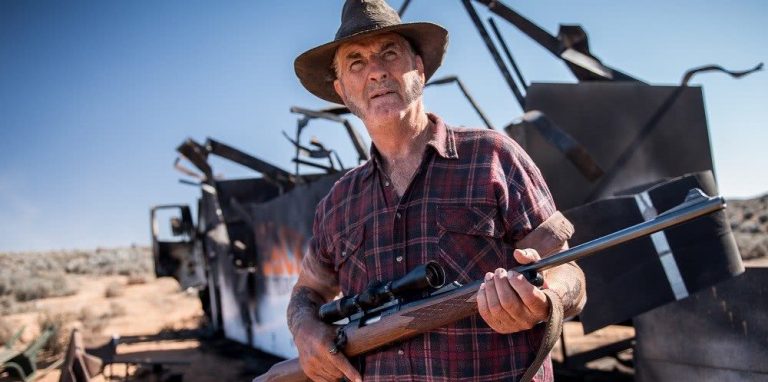The new season of Wolf Creek, the horror series based on the lauded Australian film of the same name, frequently feels more like a documentary than a feature. After all, watching a busload of tourists being hunted to their death in the barren Australian outback is a little like watching a crocodile descending on an unsuspecting wallaby, or a snake nipping at the heels of a roo and then watching as it kicks out its life in the dirt.
The show’s second season is ambitious in scope, boasting more primary characters than any previous projects in the franchise. However, at the centre of the series still stands Mick Taylor, the violent, unrelenting villain who is as iconic as the series itself.
Unlike other villains of the genre who stalk their victims silently while shrouded in mystery, Taylor, played by John Jarratt, is larger than life. He is loud, eccentric and unashamedly, abrasively Australian, often befriending the people who he later kills. As Jarratt himself explains, “without the psychopath and the serial killer element, he’d be a very well loved bloke in the district.”
The contrast is unsettling, and has been deliberately teased out by the series’ creator and director Greg McLean. “The whole thing with his character – a bit like with Ivan Milat – is that people meet and willingly jump in his car with him because he seems like a really, really nice, average Aussie bloke. He hides the truth of who he really is.”
Taylor is not the only villain present in Wolf Creek
However, not everyone is swayed by Taylor’s country charm. At the heart of the series, says McLean, is a “clash of cultures”, a theme inspired by one of McLean’s all-time favourite films, John Boorman’s 1972 classic Deliverance. After all, that film is about the fear of the foreign; the threat posed by the outsider. “It’s basically about a bunch of city guys going to the country and meeting all these characters,” McLean says. “They’re all people and all guys, but they’re basically alien to one another, and that movie demonstrates what happens when two aliens meet.”
Just as the numerous travellers in McLean’s own series prickle at Mick’s brash sense of humour and alien sensibilities, Mick sees nothing of himself in them. “They are different species,” McLean states, “and in the Wolf Creek world they’re basically prey and he’s a predator.”
Yet Taylor is not the only villain present in Wolf Creek, and the series joins a host of other films and series that have drawn on the vastness of the outback itself to evoke something primal in its audiences. McLean believes the tradition can be traced to the experience of British colonists. “You know, Australian storytelling from day dot was about people trying to survive this place that was basically a nightmare; being dumped somewhere to fend for themselves.
The trailer for Stan’s new season of Wolf Creek.
“I sort of blended a few of those things with the Australian gothic tradition, with Australian history, and some of the Koori concepts. There is a suggestion in the story that maybe there are powers in the outback and, if you spend a long time out in the outback by yourself, as Mick does, driving on these highways does something to your brain.”
The examples he provides are Ivan Milat and Bradley John Murdoch, whose infamous crimes loosely inspired the events of the first film. Their individual motivations seem so horrific as to be incomprehensible, which caused McLean to wonder whether “isolation does create a sort of madness and craziness.” In that way Mick Taylor’s character explores the question of whether the landscape itself is a source of violence and if “you could act without consequence in that isolated place, what would you do?”
When asked if he thinks his work has scared tourists away from camping, McLean is quick to laugh. While the series may be violent, he believes the outback setting is more likely to attract tourism, stating “if anything people get to see it in its most spectacular aspect, because we photograph it so beautifully and reveal it in a way that’s so gorgeous.”
Ivan Milat and Bradley John Murdoch’s crimes loosely inspired the events of the first Wolf Creek film
Of course, the series is also studded with murdered tourists, usually backpackers. There’s two reasons McLean has stuffed his work with dead outsiders – the first being a purely practical consideration. “If you prey on backpackers who are a thousand miles away and they don’t call in [to work] for two weeks, the likelihood is their friends are going to assume they’ve just gone to another place and won’t worry.”
The second, significantly more sinister reason is a nod to Australian xenophobia and prejudice; a way of combating all the ugliness and rage that goes on just under our country’s surface.“To Mick they are vermin; they’re not from here. Being a dyed in the wool racist, he believes that if they’re not Australian and they’re not from the country, and they’re not him, then they shouldn’t be here in the first place. So his idea is ‘I’m just taking out the garbage.’”
On the question of whether anyone is capable of stopping Mick on his murderous rampage – or, even whether he’s human at all – McLean has only this to say; “Mick is a mystery. There’s an element of mystery to him that can’t be discussed; you’ll never know. He’s unknowable.”
Jarratt pipes up, quick to remind us of his personal motto for the ruthless killer: “He never runs, never yells, never loses, never dies.”
The second season of Wolf Creek hits Stan this Friday December 15. Read the interview we conducted with Greg McLean about his film Jungle here .

































